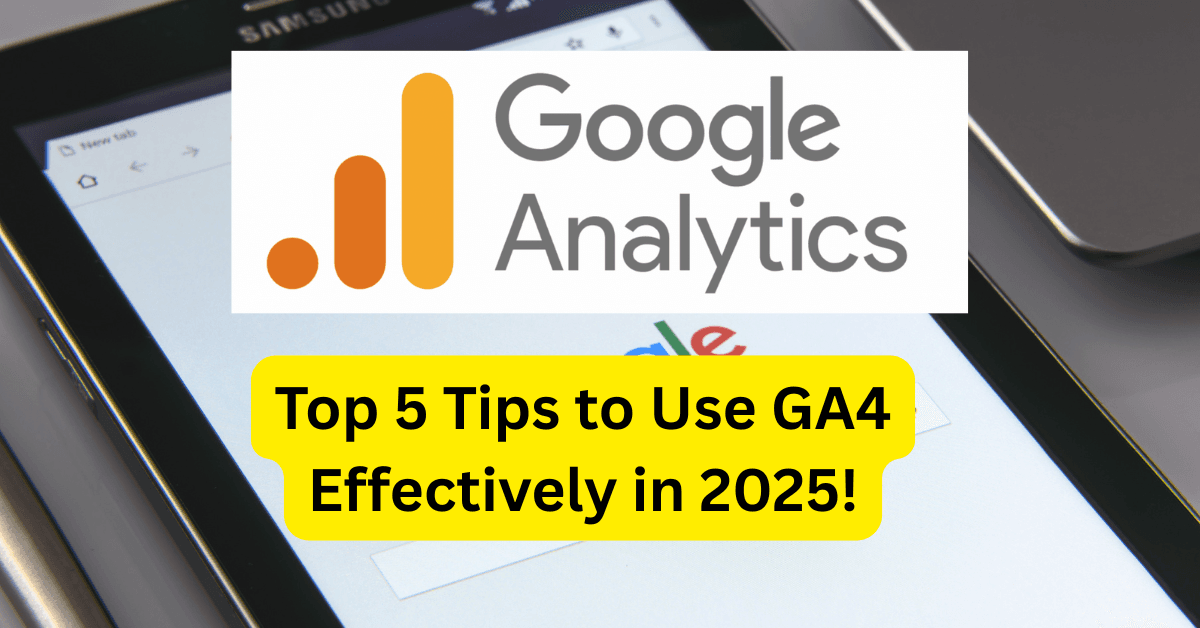
Top 5 Tips to Use GA4 Effectively in 2025!
Google Analytics 4 (GA4) has been around for a few years now. But let’s be honest—most of us are still figuring it out. The interface is different, the data model is new, and things don’t always feel intuitive. If you’ve been feeling a bit lost with GA4, you’re not alone.
And with 2025 bringing even more privacy changes and AI integration, knowing how to use GA4 effectively matters more than ever.
In this post, I’m breaking down 5 solid, practical tips to use GA4 effectively in 2025—stuff I’ve tried myself, learned the hard way, or picked up from marketers who live and breathe analytics.
Let’s dive right in.
Top 5 Tips to Use GA4 Effectively in 2025
Set Up Your Events the Right Way from the Start
If you take one thing from this post, let it be this: event setup is everything in GA4.
Unlike Universal Analytics, GA4 is built around events, not sessions. So if your events are messy, your data’s going to be… not very helpful.
What you should do:
Use clear, consistent naming for events.
- For example, don’t use “sign_up” in one place and “signup” in another. Pick a standard and stick with it.
Track key user actions.
- Like button clicks, video plays, form submissions, scroll depth, etc. Think about the actions that show interest or intent.
Mark important events as conversions
- This includes purchases, form completions, email signups—whatever matters to your business.
Use Google Tag Manager if you’re not already.
- It’s cleaner and gives you more control. You don’t need to wait for a developer to add tracking anymore.
Why it matters:
Events are how GA4 understands what’s happening on your site. Set them up wrong, and everything else—reports, funnels, audiences—gets messy fast.
Customise Your Reports for Real-World Use
The default reports in GA4 aren’t bad, but they’re not enough.
If you want GA4 to help you make decisions, you’ve got to build reports that reflect your goals. Don’t just stare at bounce rates and traffic numbers.
Try this:
- Go into Explore > Free Form and create a custom funnel.
- Want to see how many people land on your homepage → visit a product page, → add to their cart? Build that out. You don’t have to rely on pre-set paths anymore.
- Use segments to separate user types.
- For example: mobile users vs desktop, or logged-in vs new visitors.
- Add filters and comparisons to track what’s changing.
- Like how organic traffic compares to paid ads across different landing pages.
A quick example from my site:
I set up a report that tracks users who visited more than 3 pages, stayed more than 2 minutes, and clicked on a product link. That group converts 4x better than the average visitor. Would I have seen that from the default dashboard? Nope.
Use GA4’s Predictive Metrics Smartly
GA4 has predictive power now. And that’s not just a cool feature—it’s a real way to plan smarter.
Here’s how to make it work for you:
- Look at Purchase Probability and Churn Probability
- These are GA4’s AI-based guesses about who’s likely to buy or bounce. Pretty handy for email or ad retargeting.
- Use predictive audiences in Google Ads.
- If GA4 says certain users are likely to buy in the next 7 days, you can send those folks straight to a campaign. No guesswork.
- Combine with your data.
- For example, filter by source/medium to find out where your high-intent users come from.
A thought:
Don’t just use this for bragging rights (“Look, GA4 is using AI!”). Use it to build smarter marketing flows.
Dig Into User Paths (But Don’t Overcomplicate It)
User journey analysis is one of the most helpful (and honestly, most underused) features in GA4.
Why? Because it lets you see what real people do—where they go, where they drop off, and what pages pull them in.
But don’t go too deep too fast. GA4’s pathing tools can feel overwhelming.
Start simple:
- Open Explore > Path Exploration.
- Choose a starting point like “session_start” or “homepage.”
- See what paths people follow.
- You might think users go from homepage → product → checkout. But maybe they bounce around your blog first. That matters.
- Look for weird loops or drop-offs.
- If tons of people leave after hitting your FAQ page, maybe it needs rewriting. Or maybe they’re finding what they need too soon.
Why it works:
Data is only useful if you can turn it into decisions. GA4’s path tool can show you exactly what pages need work, without you needing to guess.
Connect GA4 with Other Tools (Don’t Use It in Isolation)
GA4 gets a lot better when you connect it with other stuff you’re already using.
Especially:
- Google Search Console
This shows you how users got to your site in the first place. Combine this with GA4 and you’ll know what kind of traffic sticks around.
- BigQuery
If you’re handling a large site or need more advanced analysis, GA4’s native BigQuery export is a game-changer. Even if you’re not a SQL expert, there are templates and tutorials to help.
- Google Ads
Link these together, and you can see how ad clicks turn into real actions. Not just visits, but actual conversions.
- Looker Studio (formerly Data Studio)
This lets you build dashboards that make sense to your team or clients. Visuals are easier than numbers sometimes, right?
A tip from my workflow:
I use Looker Studio to show month-over-month trends from GA4 + ad spend from Google Ads. Makes reporting way easier, and clients get it without me explaining every number.
One More Thing Is To Get Comfortable With GA4’s Quirks
Let’s be real—GA4 is still not perfect. Some things take more clicks than they should. The interface feels clunky. You’ll probably say “Where did that report go?” more than once.
But once you get past the learning curve, it does give you better control and smarter data.
Here’s what helped me:
- Watch YouTube walkthroughs.
- There’s no shame in learning by watching someone else click around.
- Practice by building stuff you’ll use.
- Don’t make a 20-step funnel just because you can. Start with what answers a question you care about.
- Stick to one or two reports at first.
- You don’t need to master everything. You just need data that helps you make smarter moves.
If you’ve been waiting for the “right time” to learn GA4, that time is gone. It’s here. It’s the standard now. But it’s also a chance to rethink how you look at website data.
You don’t need to be a tech wizard. You don’t need to know SQL (though it helps). You just need to:
- Set up your events.
- Build reports that answer real questions.
- Use predictive tools where it makes sense.
- Explore actual user paths.
- Connect GA4 with tools you’re already using.
These are not just tips to use GA4 effectively—they’re ways to stop being passive about your data and actually get value from it.



